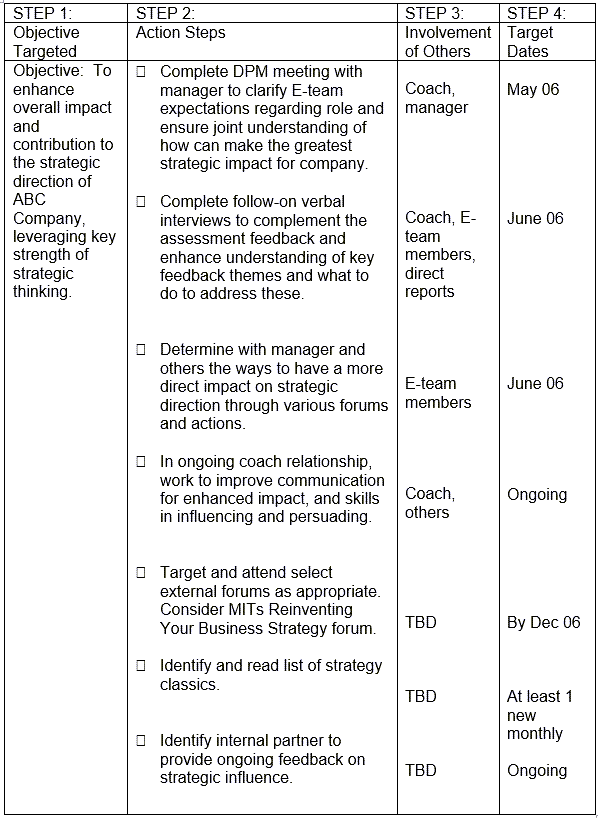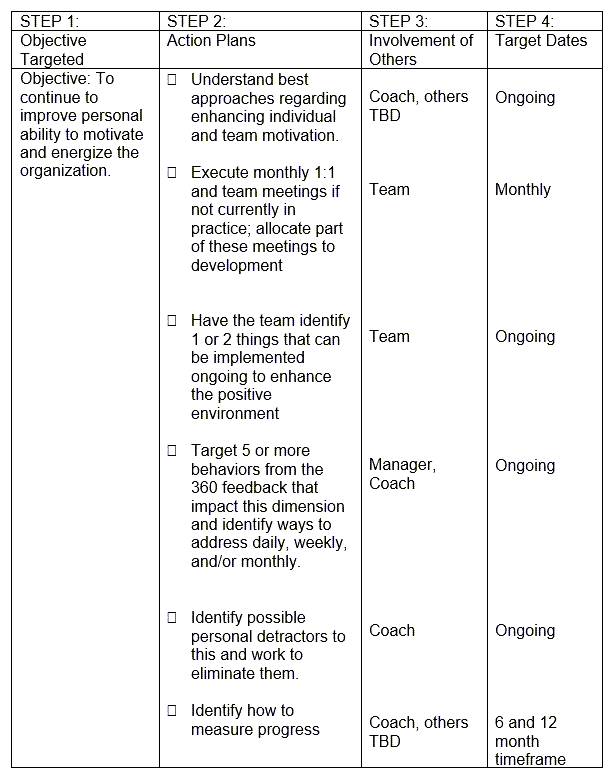Having Development Discussions
This job aid is designed specifically to help leaders and employees have strong and productive development discussions. It is meant to provide advice and guidance once the employee has completed The PROFILOR® feedback process, for three phases related to development discussions: preparing for the discussion, having the meeting, and following-up after the meeting. The following sections are organized according to these phases.
Preparing for Development Discussions:
- There are two situations to consider: first, the situation in which both the leader and employee both receive complete copies of The PROFILOR® feedback report; second, the situation in which only the employee receives a copy of the complete feedback report.
- If they are both receiving a complete copy of the feedback report, they should both consider, take notes on, and be prepared to discuss:
- Themes from The PROFILOR® feedback process, reflect perceptions of the employee’s current strengths and development needs; the leader may also have additional perceptions to add to the discussion
If only the employee is receiving a complete copy of the feedback report, the employee should identify and be prepared to discuss the key themes they see in the report. The employee may also copy sections of the report to illustrate how the themes were identified.
- Regardless of who receives the complete report, both leader and employee should prepare to discuss:
- What the employee wants for the future (e.g., professional or career goals, the employee’s perspective)
- What the organization needs from the employee for success (the leader’s perspective)
- Both the leader and employee should begin to consider the employee’s current strengths and development needs compared to the desired future state. From this comparison, identify thoughts about the biggest skill or competency gaps to fill and/or strengths to leverage for the greatest ongoing success.
- Come prepared to the meeting with any other documents or notes to help facilitate a strong and productive discussion.
- The employee or leader can schedule the meeting. If this is the first conversation of this nature, then at least an hour should be scheduled to allow for the attention needed. Less time can work if development-type conversations are typical for the leader and employee.
During the Development Discussions:
- Remember, this is not a performance review meeting. The focus should be on assisting the employee with their development ongoing. Stay focused on this objective only.
- The leader’s role in this meeting is as a coach; the employee’s role should ideally be to lead the meeting (as they ultimately own their own development). Both leader and employee need to listen and seek to understand and interpret feedback. Taking notes during the meeting is a good idea and will make follow-up after the development discussion go more smoothly.
- It works best to have the conversation in this order (the timeframes given are suggestions to help manage the time and are provided here for a one-hour meeting; adjust accordingly for a shorter or longer meeting):
- Future goals that are important to the employee (8 minutes; the employee most often leads)
- Additional insights on factors the organization sees as important to the employee’s success for current and/or future desired roles (7 minutes; the leader most often leads)
- 360-degree feedback discussion (30 minutes; interactive) – Briefly look at the feedback report sections together and discuss anything that seems important, but work quickly to identify the most important themes in terms of development needs and/or strengths to leverage (most important is generally based on importance to current and/or future success related to employee goals and/or organizational expectations). If only the employee receives a complete copy of the feedback report, then they facilitate this part of the conversation by discussing what they saw as key themes (sharing sections of the feedback report can help with this).
- Concluding the meeting (15 minutes; interactive) – End the meeting with agreement on the 2 or 3 areas that the employee should focus on in their development plan. These may be development needs or strengths to leverage even more than previously. In general, the areas identified will be related to competencies or skills. Competencies/skills may be represented in the company’s own competency framework or The PROFILOR® Also, try to agree on at least one example of an important action step related to each of the overarching development objectives.
After the Development Discussions:
- It is the employee’s responsibility to use what was learned and agreed upon in the development discussion, and create a personal development action plan.
- To do this, the employee can use the format the company provides, or if none is provided, use the format provided on the next pages. This format provides one executive-level example of leveraging a strength and one example of improving a development need. The format used to capture the ideas is much less important than the commitment to the ideas.
- To determine the objectives to include in a development plan, identify the development needs that cause the most important gaps between where the employee is now and where the employee wants/needs to be. Simultaneously, determine if there are important strengths to leverage even more that help the employee get closer to where he/she wants/needs to be.
- Most experts agree that the majority of action steps should be on-the-job activities (around 70%). This includes things like working on special projects, taking a new approach with direct reports, focusing on new goals on succession management, etc. The remaining activities should involve other people (e.g., working with a mentor), or various educational forums (e.g., formal training). In most cases, the PROFILOR® feedback report will provide development suggestions, which you can pick and choose from to create an individual action plan. But, consider all that is going on in the organization to identify ways that the employee could make a difference.
- Once the employee has created a development action plan or the area(s) they want to focus on, they should discuss it with their manager. This can be a 30-minute to one hour meeting, again depending on the employee and manager. The purpose is to ensure that the development plan focuses on the areas agreed upon in the initial meeting. It is also a chance for the leader to assist in making it a better plan, by weighing in on action steps that may not work and offering new suggestions for action steps that might work better.
Development Plan – Sample |
Building on Strengths
Please record the strengths you have chosen for greater leverage, your specific objectives and action plans, the involvement of others you require, and your target date for completion.

Addressing Development Needs
Please record the development needs you have chosen for improvement, your specific objectives and action plans, the involvement of others you require, and your target date for completion.



